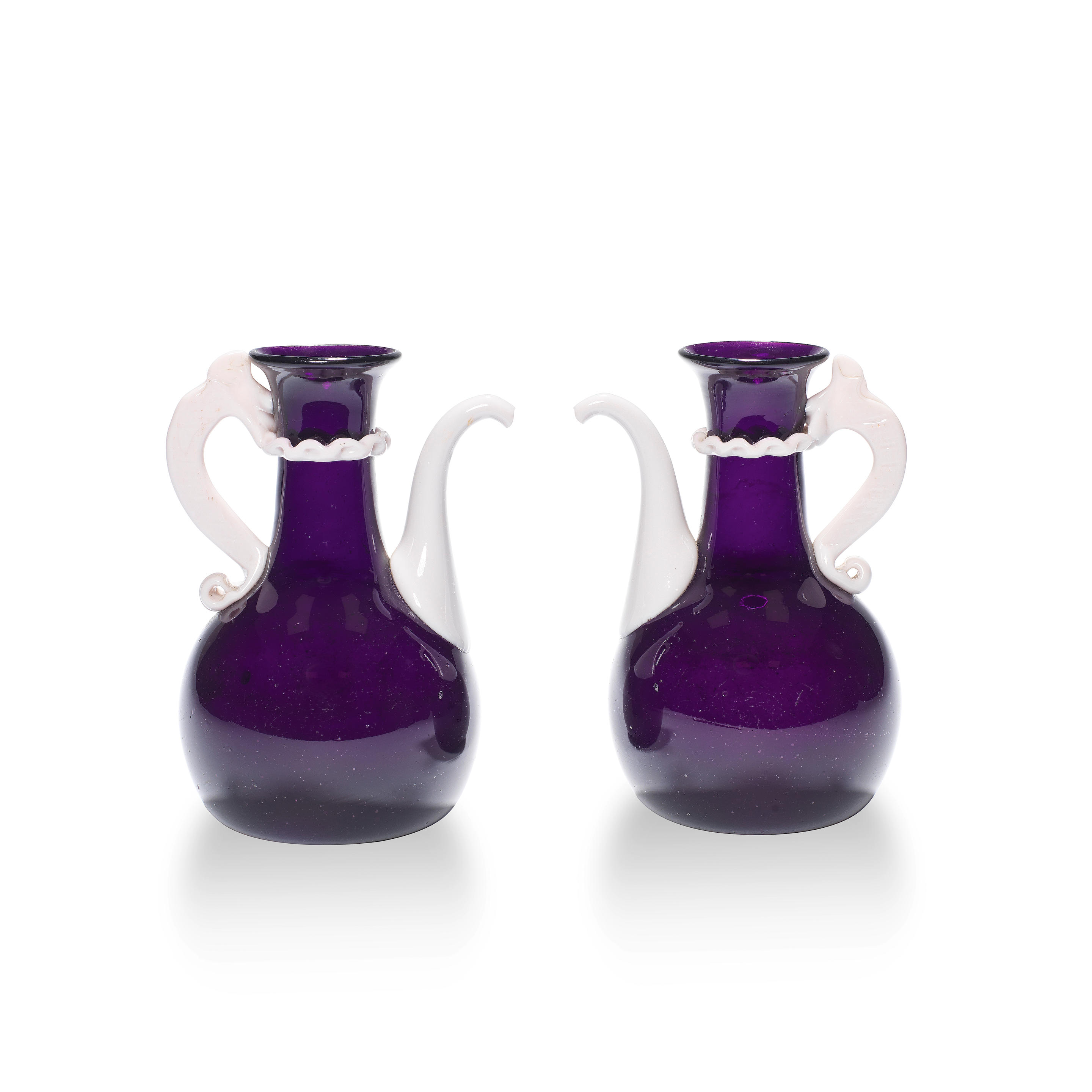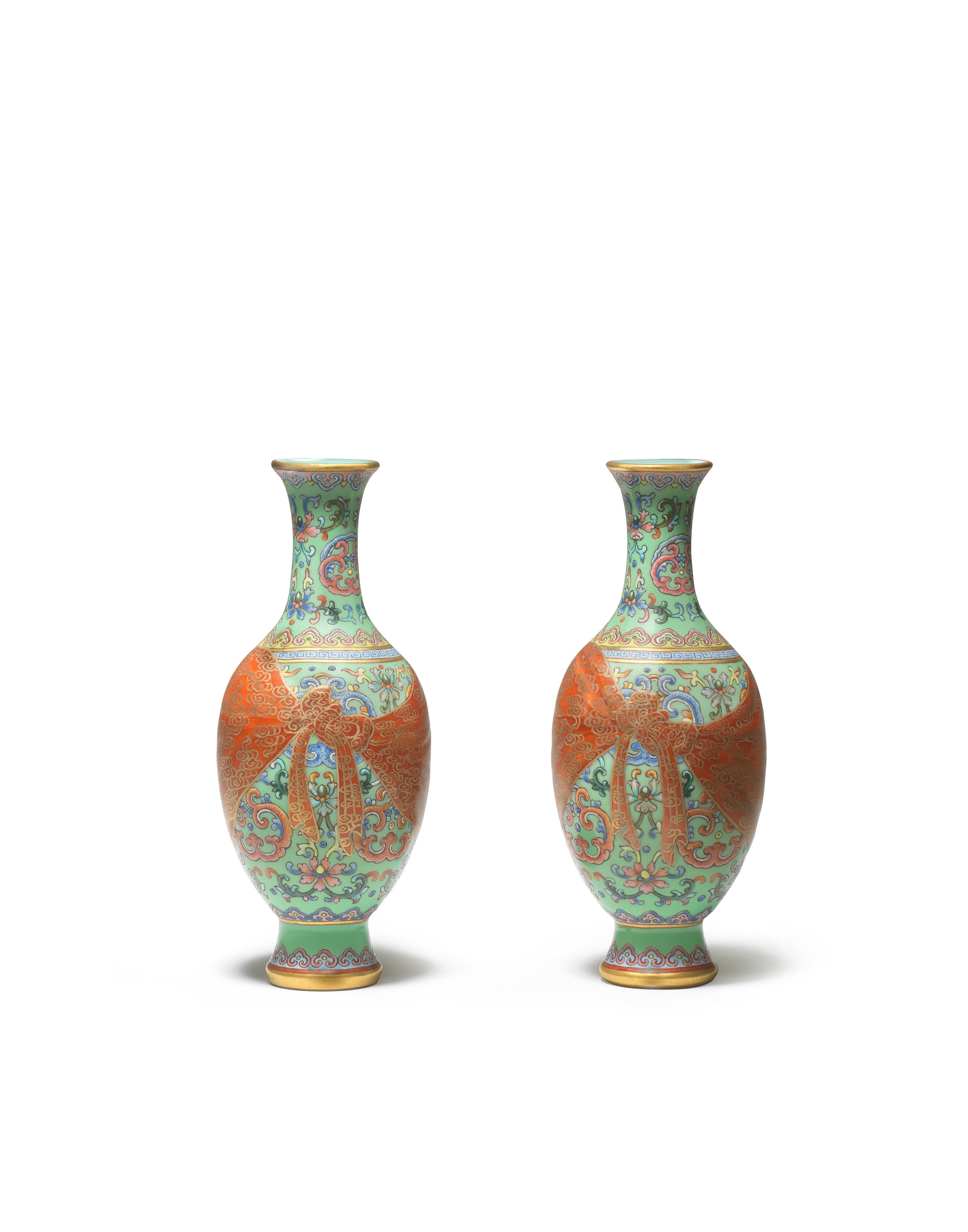A rare pair of large cloisonne’ mythical beast covered censers, 18th-19th century, each plump beast superbly cast, standing four square with stiff legs, the separate head modelled with bulging eyes and a snout-like nose, displaying a raised, open mouth, as if roaring, sharp teeth below pricked ears and a single horn, flames rising from the haunches, decorated in bright cloisonne’ enamels with blooming flowers and tendrils, with a hinge connecting the head and body, 36cm high 清十八/十九世纪 掐丝珐琅甪端熏炉一对 Provenance: Private UK Collection. Purchased in January 1953 from Louis Joseph, Knightsbridge, London Mythical beasts bearing the features described above were known as luduan, legendary creatures known to only appear whilst in presence of and serve a wise monarch, being capable of distinguishing between good and evil. This way, shaped as incense burners, flanking the imperial throne, symbolised the virtue and intelligence of the emperor. Luduan were part of of an Imperial Court assemblage known as “the throne group” and a pair is still positioned on the throne of the Hall of Supreme Harmony in the Forbidden City. In addition to these mythical beasts, a pair of elephants carrying a vase on their back, symbolic of peace, was also placed on the throne, as were a standing fan and a pair of vertical censers. The burned sandalwood emitted from the censers evoked a solemn atmosphere of imperial order. Despite their wrathful appearance, luduan protected the innocent and punished the wicked, spouting fearsome flames from their mouth. To view images of the Hall of Supreme Harmony see See The Commercial Press, Palaces of the Forbidden City, 1986, pp. 66-67. Censers shaped as luduan appear to have been employed from as early as late Ming-early Qing dynasty as a woodblock print included in Antiquities in the Collection of Shizhu Zhai, first published in 1645, shows. Two Ming luduan bearing Wanli marks, part of the collection of the Qing Court, are illustrated in the Compendium of Collection in the Palace Museum, Enamels 1: Cloisonne in the Yuan (1271-1368) and Ming (1368-1644) Dynasties, 2011, pl. 102 and 103. For viewing the woodblock print showing the luduan design see Yee and Tam, Chinese Bamboo Carving, Part 1, 1978, p. 179 fig. 15. Other comparable examples of luduan censers can be found in the Forbidden City Collection and exhibited in the Field Museum, Chicago, in Splendours of the Forbidden City, 2004, n. 37; other examples can be found in the Suzhou Museum, Colorful, Elegant, and Exquisite: A Special Exhibition of Imperial Enamel Ware from Mr. Robert Chang's Collection, 2007-2008, p. 40 and 60; Further examples in cloisonne enamel are illustrated in The Prime Cultural Relics Collected by Shenyang Imperial Palace Museum Shenyang, The Enamel Volume, 2007, pp. 90-95, pls. 4-6, and a fine pair of luduan was sold at Sotheby’s New York, 31 May 1994, lot 221 Christie's Hong Kong, 28th May 2014, lot 3538 sold for $284,994; at Sotheby’s London on 2nd Jianuary 1960, lot 131, and at Christie’s New York, 29 March 2006, lot 311, sold for $121,446 and at Christie’s Hong Kong on 30th March 2012, Lot 3920. Condition report disclaimer
A rare pair of large cloisonne’ mythical beast covered censers, 18th-19th century, each plump beast superbly cast, standing four square with stiff legs, the separate head modelled with bulging eyes and a snout-like nose, displaying a raised, open mouth, as if roaring, sharp teeth below pricked ears and a single horn, flames rising from the haunches, decorated in bright cloisonne’ enamels with blooming flowers and tendrils, with a hinge connecting the head and body, 36cm high 清十八/十九世纪 掐丝珐琅甪端熏炉一对 Provenance: Private UK Collection. Purchased in January 1953 from Louis Joseph, Knightsbridge, London Mythical beasts bearing the features described above were known as luduan, legendary creatures known to only appear whilst in presence of and serve a wise monarch, being capable of distinguishing between good and evil. This way, shaped as incense burners, flanking the imperial throne, symbolised the virtue and intelligence of the emperor. Luduan were part of of an Imperial Court assemblage known as “the throne group” and a pair is still positioned on the throne of the Hall of Supreme Harmony in the Forbidden City. In addition to these mythical beasts, a pair of elephants carrying a vase on their back, symbolic of peace, was also placed on the throne, as were a standing fan and a pair of vertical censers. The burned sandalwood emitted from the censers evoked a solemn atmosphere of imperial order. Despite their wrathful appearance, luduan protected the innocent and punished the wicked, spouting fearsome flames from their mouth. To view images of the Hall of Supreme Harmony see See The Commercial Press, Palaces of the Forbidden City, 1986, pp. 66-67. Censers shaped as luduan appear to have been employed from as early as late Ming-early Qing dynasty as a woodblock print included in Antiquities in the Collection of Shizhu Zhai, first published in 1645, shows. Two Ming luduan bearing Wanli marks, part of the collection of the Qing Court, are illustrated in the Compendium of Collection in the Palace Museum, Enamels 1: Cloisonne in the Yuan (1271-1368) and Ming (1368-1644) Dynasties, 2011, pl. 102 and 103. For viewing the woodblock print showing the luduan design see Yee and Tam, Chinese Bamboo Carving, Part 1, 1978, p. 179 fig. 15. Other comparable examples of luduan censers can be found in the Forbidden City Collection and exhibited in the Field Museum, Chicago, in Splendours of the Forbidden City, 2004, n. 37; other examples can be found in the Suzhou Museum, Colorful, Elegant, and Exquisite: A Special Exhibition of Imperial Enamel Ware from Mr. Robert Chang's Collection, 2007-2008, p. 40 and 60; Further examples in cloisonne enamel are illustrated in The Prime Cultural Relics Collected by Shenyang Imperial Palace Museum Shenyang, The Enamel Volume, 2007, pp. 90-95, pls. 4-6, and a fine pair of luduan was sold at Sotheby’s New York, 31 May 1994, lot 221 Christie's Hong Kong, 28th May 2014, lot 3538 sold for $284,994; at Sotheby’s London on 2nd Jianuary 1960, lot 131, and at Christie’s New York, 29 March 2006, lot 311, sold for $121,446 and at Christie’s Hong Kong on 30th March 2012, Lot 3920. Condition report disclaimer







.jpg)

/930/1214930.jpg)





Testen Sie LotSearch und seine Premium-Features 7 Tage - ohne Kosten!
Lassen Sie sich automatisch über neue Objekte in kommenden Auktionen benachrichtigen.
Suchauftrag anlegen